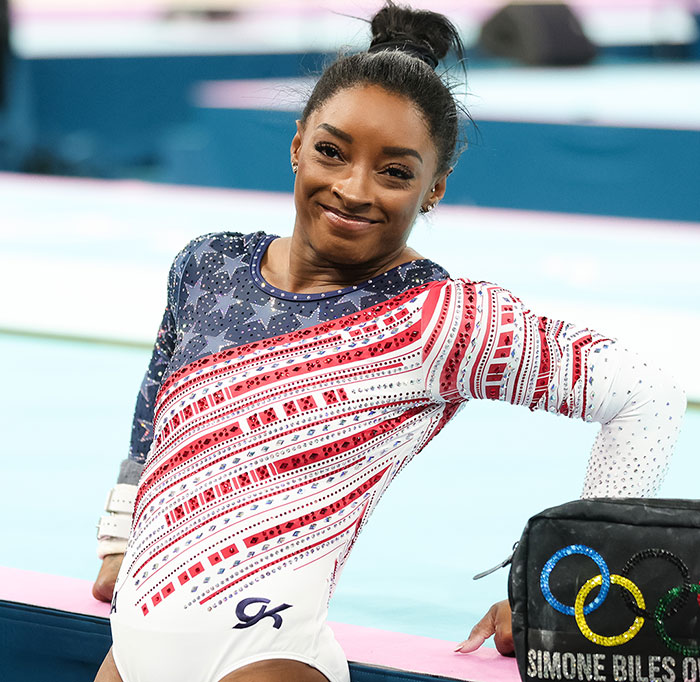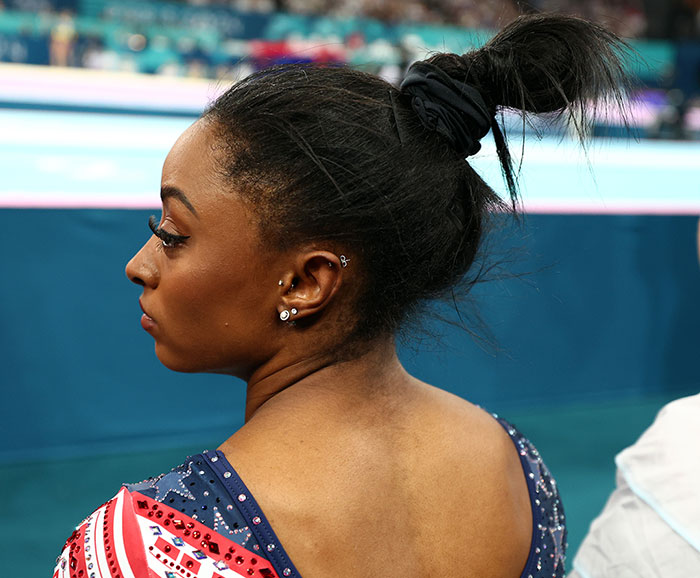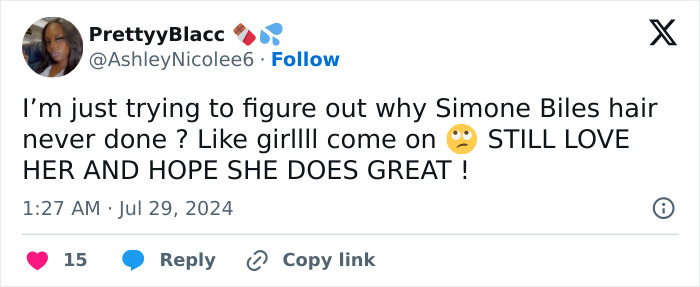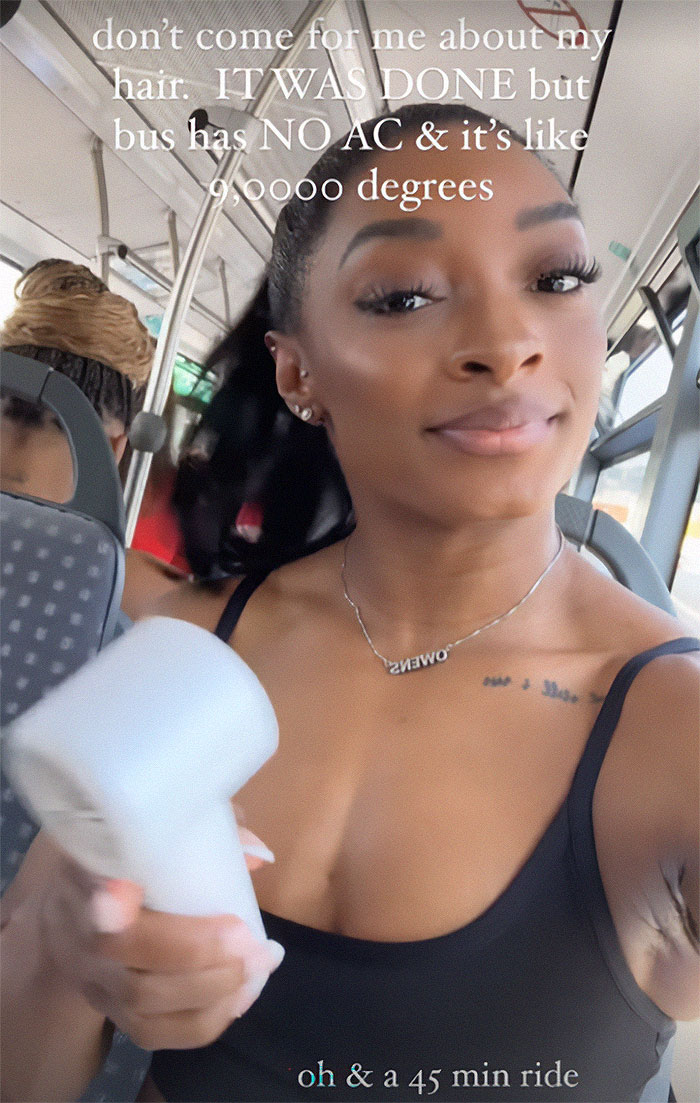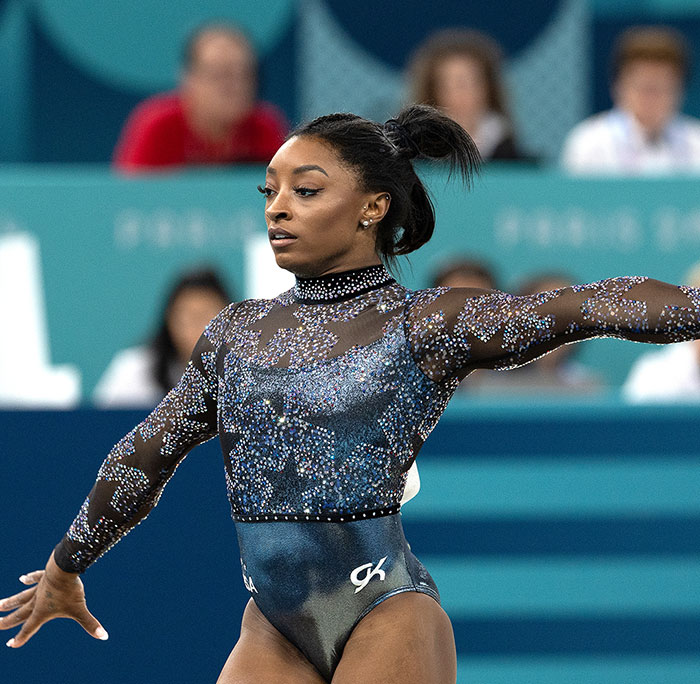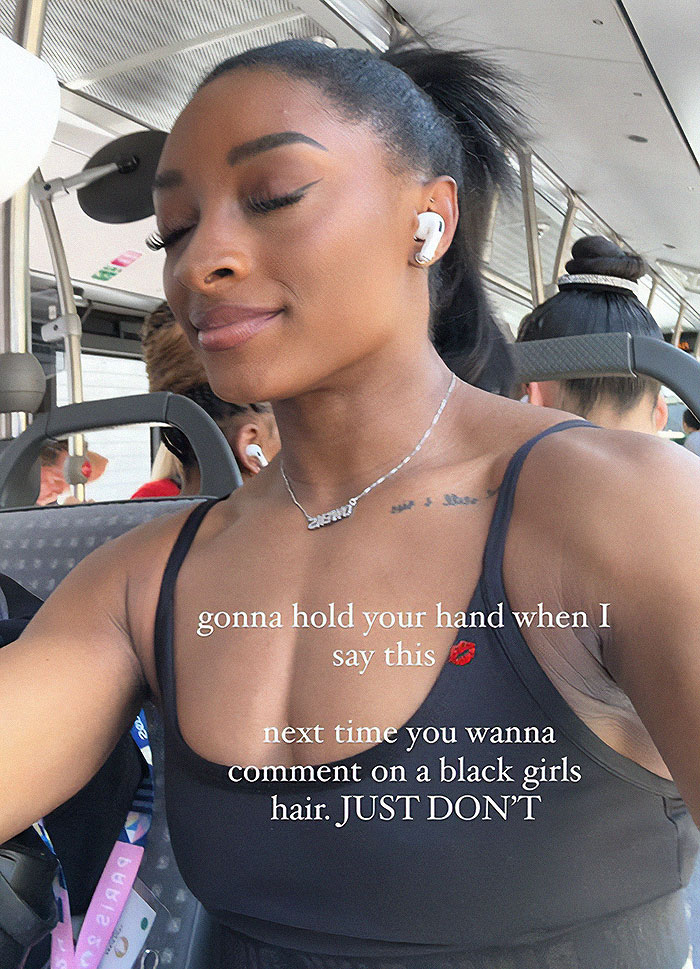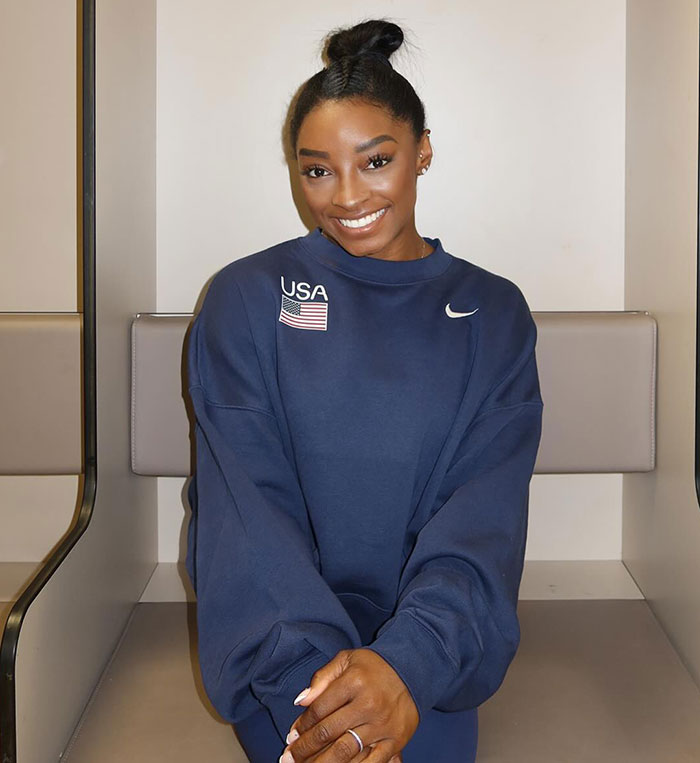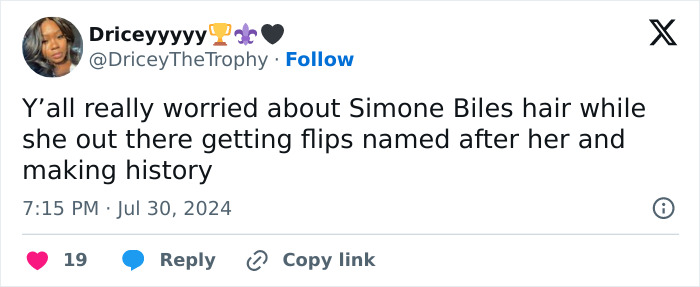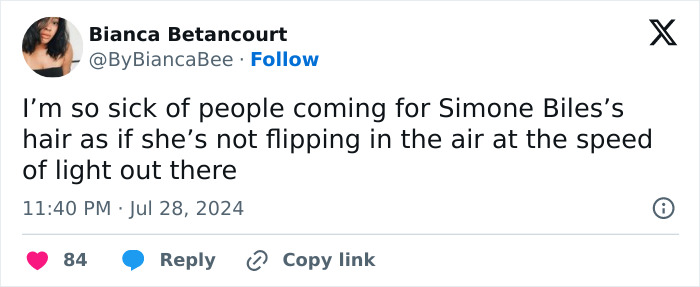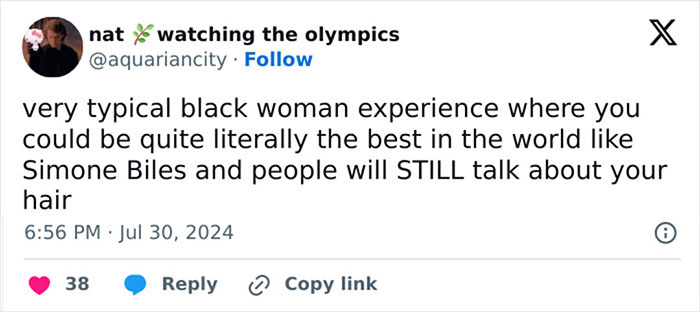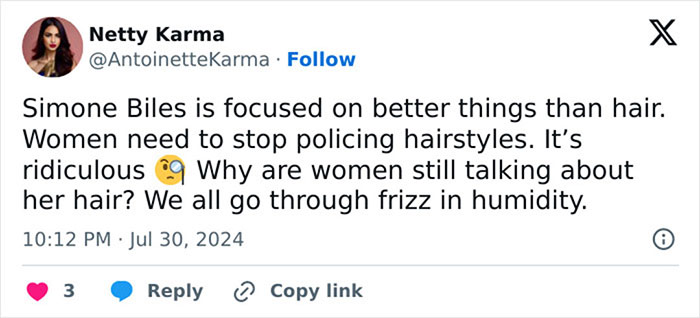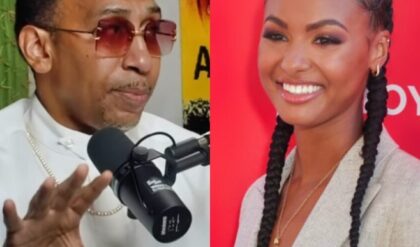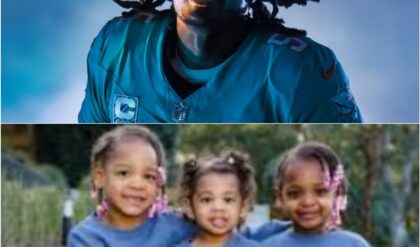Simone Biles, who earned the US record for the most Olympic medals in gymnastics history on Tuesday (July 30), had a special message for haters daring to criticize her hair. Highlighting Paris, France’s scorching temperatures, the most decorated gymnast of all time slammed the racial bias.
Taking to her Instagram page on Tuesday, Simone shared two stories that fired back at people who may have disapproved of her hairstyle while she was busy winning her fifth Olympic gold medal.
“Don’t come for me about my hair,” the 27-year-old captioned a video of herself. “IT WAS DONE but bus has NO AC and it’s like 9,000 degrees. Oh & a 45-minute ride.”
The gymnast filmed herself cooling her face with a handheld fan in the video behind the text, apparently on a bus without air conditioning en route to the competition, where she helped Team USA win the all-around team event after scoring 14.666 on the floor.
Simone Biles earned the US record for the most Olympic medals in gymnastics history on Tuesday (July 30)
Image credits: Pete Dovgan/Speed Media/Icon Sportswire
The 2024 Paris Olympic Games famously launched with a rain-soaked opening ceremony that drenched athletes and spectators alike.
Nevertheless, athletes are currently enduring the opposite experience since most of France has been under heat warnings, with temperatures in Paris hitting 36 degrees Celsius (97 Fahrenheit), AP News reported on Tuesday.
Image credits: Amin Mohammad Jamali/Getty Images
Simone had a special message for haters daring to criticize her hair
In her following Instagram post, Simone warned: “Gonna hold your hand when I say this.
“Next time you wanna comment on a Black girls hair. JUST DON’T.”
Highlighting Paris, France’s scorching temperatures, the most decorated gymnast of all time slammed the racial bias
The Legal Defense Fund (LDF), an American civil rights organization, explains that Black hair goes beyond just cultural differences. The waves, curls, coils, and ringlets that Black hair can have cause it to have unique needs.
According to the organization, Black people often choose to wear “protective hairstyles,” like braids, twists, and locs, to maintain healthy hair and prevent breakage.
Image credits: simonebiles
These hairstyles can be worn for long stretches of time without constant manipulation. The alternative is often to use chemical or heat straighteners that can damage the hair in the short and long term.
Black hair is also an expression of identity and culture, the LDF says. It’s a representation of history and carries deep emotional significance. Historically, Black hair has carried a profound symbolism.
Moreover, cornrows, locs, twists, afros, bantu knots, and more all have historic connections to Black pride, culture, religion, and history, which makes wearing these styles all the more significant.
Taking to her Instagram page on Tuesday, Simone shared stories firing back at people who may have disapproved of her hairstyle
Image credits: Steve Christo – Corbis/Corbis
“Touching is clearly not okay, but there are a number of other things that non-Black people, should also consider when talking about Black women’s hair,” Refinery29 wrote in 2018. “Things like gawking at, commenting on, or cracking jokes about their latest style switch-up are equally inappropriate and can make Black women feel singled out.”
“Today, Black women continue to face discrimination in the workplace,” Refinery29 added. “Whether it’s racial bias and stereotyping, micro-aggressions from coworkers and superiors, or disproportionate instances of sexual harassment, Black women often experience a very different version of the workplace compared to their white counterparts.”
A recent research conducted on 2,000 women of color in workplaces across the UK showed that 75% of them had experienced racism at work and 27% had suffered racial slurs.
Image credits: simonebiles
Simone addressed the racial bias against her hair in her Netflix documentary, Simone Biles Rising, which was released on July 17.
Recalling one particular remark about her locs looking “crunchy,” the athlete said: “People are way too comfortable commenting things.
“I think the beauty standard, everything, is just too much.”
“Don’t come for me about my hair,” Simone said. “IT WAS DONE but bus has NO AC and it’s like 9,000 degrees.”
In addition to her five gold medals, the gymnastics superstar also won a silver and a bronze Olympic medal, in addition to 20 World Championship gold medals.
On Tuesday, as the scores were read out, the stadium in Paris rang out in cheers, and Simone and her teammates — Jade Carey, Jordan Chiles, Hezly Rivera, and Sunisa Lee — rushed the stage with the American flag, unable to keep the smiles and tears away, Hello Magazine reported on Wednesday (July 31).
Simone was the final athlete to perform on the day, ending her routine with a full-twisting front flip through to a double-double before following it up with her original namesake skill, a double layout with a half twist, Hello Magazine explained.
Image credits: simonebiles
The gymnast performed another double layout to finish, and despite falling outside of the floor lines twice, the score was high enough to overtake Team GB, who had been sitting in third place.
Their total was 171.296, a solid six points above second-place finishers Italy; Brazil came third, winning its first Olympic medal in the sport ever, as per Hello Magazine.
In women’s gymnastics at the Olympics, the scoring system combines two main components, with the first being a difficulty score (D-Score).
Simone addressed racial bias against her hair in her Netflix documentary, Simone Biles Rising, which was released on July 17
The D-Score reflects the difficulty of the routine and is calculated based on the value of the elements performed and the composition requirements.
There is no maximum limit for the D-Score; it depends on the gymnast’s skills and the complexity of their routine.
The second component is the execution score (E-Score), which starts at 10.0 and reflects the quality of the performance.
Deductions are made for errors such as poor form, balance checks, and falls. The higher the execution quality, the closer the E-Score will be to 10.
The Final Score is the sum of the D-Score and the E-Score.
Bored Panda follows Rachele Kanigel’s 2019 Diversity Style Guide, which encourages the capitalization of “Black” and not “white” when referring to groups in racial, ethnic, or cultural terms.
